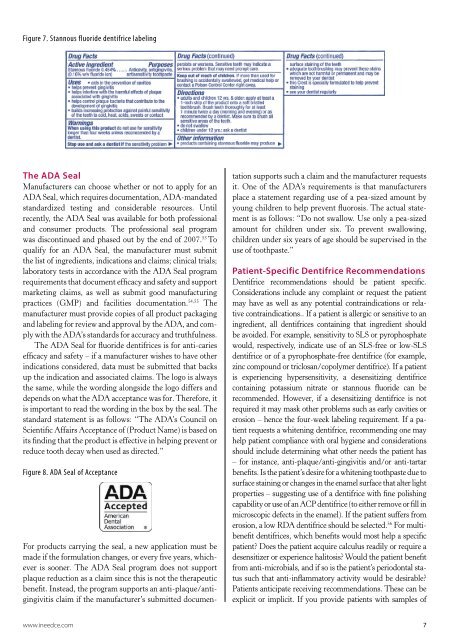Reflections on Dentifrice Ingredients, Benefits and ... - IneedCE.com
Reflections on Dentifrice Ingredients, Benefits and ... - IneedCE.com
Reflections on Dentifrice Ingredients, Benefits and ... - IneedCE.com
Create successful ePaper yourself
Turn your PDF publications into a flip-book with our unique Google optimized e-Paper software.
Figure 7. Stannous fluoride dentifrice labeling<br />
The ADA Seal<br />
Manufacturers can choose whether or not to apply for an<br />
ADA Seal, which requires documentati<strong>on</strong>, ADA-m<strong>and</strong>ated<br />
st<strong>and</strong>ardized testing <strong>and</strong> c<strong>on</strong>siderable resources. Until<br />
recently, the ADA Seal was available for both professi<strong>on</strong>al<br />
<strong>and</strong> c<strong>on</strong>sumer products. The professi<strong>on</strong>al seal program<br />
was disc<strong>on</strong>tinued <strong>and</strong> phased out by the end of 2007. 53 To<br />
qualify for an ADA Seal, the manufacturer must submit<br />
the list of ingredients, indicati<strong>on</strong>s <strong>and</strong> claims; clinical trials;<br />
laboratory tests in accordance with the ADA Seal program<br />
requirements that document efficacy <strong>and</strong> safety <strong>and</strong> support<br />
marketing claims, as well as submit good manufacturing<br />
practices (GMP) <strong>and</strong> facilities documentati<strong>on</strong>. 54,55 The<br />
manufacturer must provide copies of all product packaging<br />
<strong>and</strong> labeling for review <strong>and</strong> approval by the ADA, <strong>and</strong> <strong>com</strong>ply<br />
with the ADA’s st<strong>and</strong>ards for accuracy <strong>and</strong> truthfulness.<br />
The ADA Seal for fluoride dentifrices is for anti-caries<br />
efficacy <strong>and</strong> safety – if a manufacturer wishes to have other<br />
indicati<strong>on</strong>s c<strong>on</strong>sidered, data must be submitted that backs<br />
up the indicati<strong>on</strong> <strong>and</strong> associated claims. The logo is always<br />
the same, while the wording al<strong>on</strong>gside the logo differs <strong>and</strong><br />
depends <strong>on</strong> what the ADA acceptance was for. Therefore, it<br />
is important to read the wording in the box by the seal. The<br />
st<strong>and</strong>ard statement is as follows: “The ADA’s Council <strong>on</strong><br />
Scientific Affairs Acceptance of (Product Name) is based <strong>on</strong><br />
its finding that the product is effective in helping prevent or<br />
reduce tooth decay when used as directed.”<br />
Figure 8. ADA Seal of Acceptance<br />
For products carrying the seal, a new applicati<strong>on</strong> must be<br />
made if the formulati<strong>on</strong> changes, or every five years, whichever<br />
is so<strong>on</strong>er. The ADA Seal program does not support<br />
plaque reducti<strong>on</strong> as a claim since this is not the therapeutic<br />
benefit. Instead, the program supports an anti-plaque/antigingivitis<br />
claim if the manufacturer’s submitted documentati<strong>on</strong><br />
supports such a claim <strong>and</strong> the manufacturer requests<br />
it. One of the ADA’s requirements is that manufacturers<br />
place a statement regarding use of a pea-sized amount by<br />
young children to help prevent fluorosis. The actual statement<br />
is as follows: “Do not swallow. Use <strong>on</strong>ly a pea-sized<br />
amount for children under six. To prevent swallowing,<br />
children under six years of age should be supervised in the<br />
use of toothpaste.”<br />
Patient-Specific <strong>Dentifrice</strong> Re<strong>com</strong>mendati<strong>on</strong>s<br />
<strong>Dentifrice</strong> re<strong>com</strong>mendati<strong>on</strong>s should be patient specific.<br />
C<strong>on</strong>siderati<strong>on</strong>s include any <strong>com</strong>plaint or request the patient<br />
may have as well as any potential c<strong>on</strong>traindicati<strong>on</strong>s or relative<br />
c<strong>on</strong>traindicati<strong>on</strong>s.. If a patient is allergic or sensitive to an<br />
ingredient, all dentifrices c<strong>on</strong>taining that ingredient should<br />
be avoided. For example, sensitivity to SLS or pyrophosphate<br />
would, respectively, indicate use of an SLS-free or low-SLS<br />
dentifrice or of a pyrophosphate-free dentifrice (for example,<br />
zinc <strong>com</strong>pound or triclosan/copolymer dentifrice). If a patient<br />
is experiencing hypersensitivity, a desensitizing dentifrice<br />
c<strong>on</strong>taining potassium nitrate or stannous fluoride can be<br />
re<strong>com</strong>mended. However, if a desensitizing dentifrice is not<br />
required it may mask other problems such as early cavities or<br />
erosi<strong>on</strong> – hence the four-week labeling requirement. If a patient<br />
requests a whitening dentifrice, re<strong>com</strong>mending <strong>on</strong>e may<br />
help patient <strong>com</strong>pliance with oral hygiene <strong>and</strong> c<strong>on</strong>siderati<strong>on</strong>s<br />
should include determining what other needs the patient has<br />
– for instance, anti-plaque/anti-gingivitis <strong>and</strong>/or anti-tartar<br />
benefits. Is the patient’s desire for a whitening toothpaste due to<br />
surface staining or changes in the enamel surface that alter light<br />
properties – suggesting use of a dentifrice with fine polishing<br />
capability or use of an ACP dentifrice (to either remove or fill in<br />
microscopic defects in the enamel). If the patient suffers from<br />
erosi<strong>on</strong>, a low RDA dentifrice should be selected. 56 For multibenefit<br />
dentifrices, which benefits would most help a specific<br />
patient? Does the patient acquire calculus readily or require a<br />
desensitizer or experience halitosis? Would the patient benefit<br />
from anti-microbials, <strong>and</strong> if so is the patient’s period<strong>on</strong>tal status<br />
such that anti-inflammatory activity would be desirable?<br />
Patients anticipate receiving re<strong>com</strong>mendati<strong>on</strong>s. These can be<br />
explicit or implicit. If you provide patients with samples of<br />
www.ineedce.<strong>com</strong> 7

















